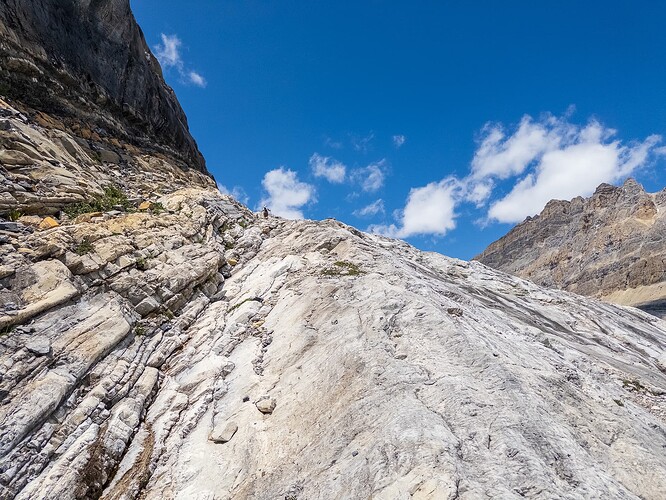That makes sense to me - the language here definitely isn’t final and I appreciate the constructive feedback. I actually like how T3 is along the lines of “someone would likely use their hands for balance” vs YDS 2 in which people can get a little dick measuring about not using their hands “it was Class 1 for me, might not be for you hur hur”.
I was able to walk up the light gray granite colored slab without using my hands by picking good lines, having vibram soles, and some experience. My partner who is shorter and a little less risk prone used her hands, as did most people in another party we saw going up.
It’s an interesting case for that difficulty, as the smoothness=* of it is less of an issue than being somewhat exposed and needing to micro-route find.
This a somewhat ambiguous example (as it would be in SAC or YDS), but I’d probably put it a step above surefooted_hiking, though that is what it was for me going up. Going down we stayed tighter in and I was definitely using my hands for balance on that route.
While the photos above are of a no visibility route that doesn’t belong in OSM, I’ve come across trailed places that are similar. Most that spring to mind have Via Ferrata which obviously shifts things (one spot in NZ was similar to this, but the cables didn’t seem useful outside of during rain).
Mantles in use_of_hands??
One thing that I would really want feedback for is including short mantles in use_of_hands. I feel they are closer to hands_for_balance which is what the value would be without them than proper scrambling, but probably not worth making an entirely new key around. I could see dropping that from the value, keeping it hands_for_balance then maybe just marking mantles as a hazard or feature as a node when they occur. In the southwest there’s a lot of trails that are mostly surefooted_hiking with stretches of hands_for_balance but then there’s an occasional mantle or two.


